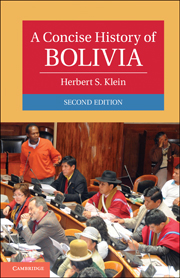Book contents
- Frontmatter
- Contents
- Preface to the Second Edition
- Preface to the First Edition
- 1 GEOGRAPHY AND PRE-COLUMBIAN CIVILIZATION
- 2 THE CREATION OF A COLONIAL SOCIETY
- 3 LATE COLONIAL SOCIETY: CRISIS AND GROWTH
- 4 REVOLUTION AND THE CREATION OF A NATION-STATE, 1809–1841
- 5 THE CRISIS OF THE STATE, 1841–1880
- 6 THE AGES OF SILVER AND TIN, 1880–1932
- 7 DISINTEGRATION OF THE ESTABLISHED ORDER, 1932–1952
- 8 FROM THE NATIONAL REVOLUTION TO THE COLD WAR, 1952–1982
- 9 CREATING A MULTIETHNIC DEMOCRACY, 1982–2002
- 10 THE EMERGENCE OF A MESTIZO AND INDIGENOUS ELITE, 2002–2010
- Political Chronology
- Tables
- Bibliography
- Index
- Titles in the series
8 - FROM THE NATIONAL REVOLUTION TO THE COLD WAR, 1952–1982
Published online by Cambridge University Press: 01 June 2011
- Frontmatter
- Contents
- Preface to the Second Edition
- Preface to the First Edition
- 1 GEOGRAPHY AND PRE-COLUMBIAN CIVILIZATION
- 2 THE CREATION OF A COLONIAL SOCIETY
- 3 LATE COLONIAL SOCIETY: CRISIS AND GROWTH
- 4 REVOLUTION AND THE CREATION OF A NATION-STATE, 1809–1841
- 5 THE CRISIS OF THE STATE, 1841–1880
- 6 THE AGES OF SILVER AND TIN, 1880–1932
- 7 DISINTEGRATION OF THE ESTABLISHED ORDER, 1932–1952
- 8 FROM THE NATIONAL REVOLUTION TO THE COLD WAR, 1952–1982
- 9 CREATING A MULTIETHNIC DEMOCRACY, 1982–2002
- 10 THE EMERGENCE OF A MESTIZO AND INDIGENOUS ELITE, 2002–2010
- Political Chronology
- Tables
- Bibliography
- Index
- Titles in the series
Summary
Bolivia in 1950 was still a predominantly rural society, the majority of whose population was only marginally integrated into the national economy. Of all economically active persons registered in the census of 1950, fully 72 percent were engaged in agriculture and allied industries. Yet this workforce only produced some 33 percent of the gross national product, a discrepancy that clearly indicates the serious economic retardation of this sector. But since 1900, Bolivian society had experienced marked changes in its social composition. The urban population (those living in cities or towns of five thousand or more) had risen from 14 percent to 23 percent of the national population, and in each of the departments of the country, the major urban centers had grown faster than the department as a whole. The level of literacy and the number of children attending school also increased in the same period, especially after the major investments in education carried out by the post-Chaco regimes. Between 1900 and 1950 literates rose from 17 percent of the population to 31 percent, and the pre-university student population went from some 23,000 to 139,000, or from 1 to 5 percent of the total population. At the top, however, much less change had occurred, and while the number of university students by 1951 had reached twelve thousand, only 132 persons in the entire country had graduated with postsecondary degrees in that year.
- Type
- Chapter
- Information
- A Concise History of Bolivia , pp. 209 - 238Publisher: Cambridge University PressPrint publication year: 2011



